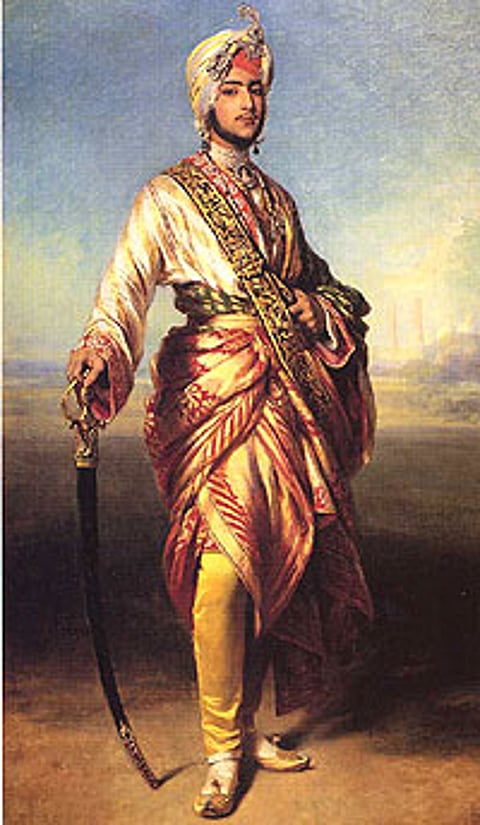The Scattered Ashes of a Legend
Empire's marionette, Duleep Singh could only align his life with an idle absurdity
The inevitable clash with the British took place in December 1845 to February 1846. After the bitter battle of Subraon was lost, the British marched into Lahore. The little maharaja was made to sit with brown and white old men under a shimmering shamiana and signed a treaty of submission. The rich half of the kingdom, the Doaba, was seceded, and the little king was ruled over by Resident Lawrence. Three years later, in 1849, Dalhousie converted a minor rebellion in Multan into the second Sikh War and annexed the Punjab. The Sikh Raj was over. The boy raja was taken to Fattehgarh on the Ganges, under padre tutors, converted to Christianity, and five years later taken to England. Queen Victoria treated him as a colorful Indian mascot. He played with her children; lived at Osborne as a favoured guest, and became a star shooter of pheasants. Winterhalter painted him. He settled at Elveden, close to Thetford, near Cambridge.
The Sikh hunger for the lost kingdom has never faded. In 1967 I went to Cambridge. I had already studied all the 19th century British writings on the Sikhs, and the two brutally fought Sikh wars. I went to Elveden, where Duleep Singh lies buried, and wrote lurid, sentimental articles in the Punjab papers, asking for his bones to be brought back. Early Sikh migrants to the UK started pilgrimages to Elveden by the bus-loads. They made a mess of that elegant countryside, camping in the ancient church, eating aalu puris. Now, Prince Charles has inaugurated a Duleep Singh statue, which looks nothing like him. But history has to be polished up.

Royal drapes: Winterhalter's 1854 portrait shows Duleep Singh in his prime |
Navtej Sarna’s book, a mild fictionalisation of the broad contours of the Duleep story, goes over all the details of his sad-comic life. It even ends with his desire to bring Duleep’s century-old dust to the Punjab, to scatter on the five rivers. I am amused, for I started this absurd idea in 1968 from Cambridge. I no longer believe there is any sense in trying to do this. Ranjit Singh was a real king, and a great one, as the world acknowledges. The boy Duleep was a fiction and a victim of history. When he was put on the throne, the durbar was in turmoil, his paternity itself was in question, and Rani Jindan at age 20 was herself a personality that aroused intense debate and emotions. The boy lived through all the turmoil, even seeing his uncle Jawahar Singh pulled off an elephant and killed by the Sikh army, which was ruled by their own panchayats. In England he was an isolated, idle figure, available to the British aristocracy for their country-house amusements.
Duleep was short, and soon ran to fat with all his excesses. Baldness reduced any remaining dignity. A spendthrift, he refused to recognise that he was no king, only a prisoner in a gilded cage. His anger and rebellion in later life was only about his need for more allowances. His return to the Sikh fold was fake, and in his last letters from Paris, he again pleaded Christian loyalty. Frustration and petulance led him to a self-imagined rebellion against the British empire in its heyday, and grandiose dreams of enlisting the help of the Czar to conquer India. He had foolish dreams of the Sikh people and soldiers rising in his cause. He begged docile maharajas to fund him. The money, sadly, was for his second chambermaid-wife, Ida. Of course, nobody gave him a penny. His sad end was in a cheap Paris hotel, after he had cried and begged the Queen’s pardon, hoping for a restoration of some allowances. It is a pathetic, hopeless life, an embarrassment to the Sikhs. He certainly lived in adversity from childhood. But if he was anything like a Sikh, he should have known how to maintain dignity under the gravest provocations and circumstances. Sikhs, rich and poor, high and low, are known to do this.
Sarna has brought out this history through Mangla, the dasi of Rani Jindan, and Arur Singh, a Sikh peasant who faithfully served Duleep for many years for no reward. I find Arur Singh much the nobler man. Rani Jindan and Mangla, both notorious in their time, showed in their own way plenty of guts and courage. The way Jindan escaped from Chunar fort and through the jungles of the Terai to Nepal is no small achievement. The book is a pleasant, easy read, and brings out the quixotic tale of Duleep Singh. I think enough has been written on the man, and he should be allowed to rest. I also think the Sikhs should give up this illusion that he was our last king. He was no king, just a caricature.